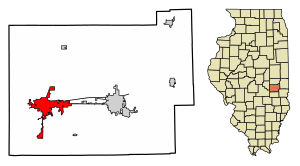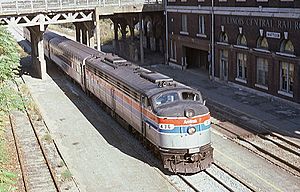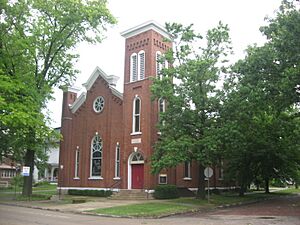Mattoon, Illinois facts for kids
Quick facts for kids
Mattoon, Illinois
|
|
|---|---|

Starr Hotel, built in 1888 and listed on the National Register of Historic Places
|
|

Location of Mattoon in Coles County, Illinois.
|
|
| Country | |
| State | |
| County | Coles |
| Townships | Mattoon, Lafayette, Paradise |
| Named for | William Mattoon |
| Area | |
| • Total | 10.32 sq mi (26.72 km2) |
| • Land | 10.31 sq mi (26.71 km2) |
| • Water | 0.00 sq mi (0.01 km2) |
| Elevation | 719 ft (219 m) |
| Population
(2020)
|
|
| • Total | 16,870 |
| • Density | 1,635.64/sq mi (631.55/km2) |
| Time zone | UTC−6 (CST) |
| • Summer (DST) | UTC−5 (CDT) |
| ZIP Code(s) |
61938
|
| Area code(s) | 217 |
| FIPS code | 17-47553 |
| GNIS ID | 2395046 |
| Wikimedia Commons | Mattoon, Illinois |
| Website | www.mattoon.illinois.gov |
Mattoon (/ˈmæt.tun/ MAT-toon) is a city in Coles County, Illinois, United States. About 16,870 people lived there in 2020. Mattoon is home to Lake Land College. It is also very close to Charleston. Both cities are important parts of the Charleston–Mattoon Micropolitan Area.
Contents
History of Mattoon
Early Days and First Settlers
The land around Mattoon was a mix of forests and prairie (grassy plains). Early settlers liked the forests because they provided wood for building homes and for fuel. Most of these first settlers came from wooded areas like Indiana, Kentucky, and Tennessee.
In 1826, Charles Sawyer from Kentucky was the first known white settler in the Mattoon area. He built his cabin near the Little Wabash River. Soon, other families joined him, including Dr. John Epperson, the first doctor in the county. They built log cabins without using iron or nails. Life was simple, but people worked together.
Farmers grew corn and vegetables. They also raised hogs and hunted wild animals like deer and turkeys for food. Wolves were a problem for their farm animals.
The first school opened in 1827–28 in Paradise Township. Students paid a small fee to attend. In 1844–45, the first proper schoolhouse was built in what would become Mattoon.
On Christmas Day, 1830, Coles County was created. It was named after Edward Coles, who was the second governor of Illinois.
In 1836, "Old State Road" was built, which helped people travel through the area. Another important landmark was "The Lone Elm Tree." It guided travelers until it was cut down in 1950 due to disease. A plaque now marks its spot.
Railroads Bring Growth (1850–1900)
Mattoon grew because of the railroads. In 1854, surveyors found that the Illinois Central Railroad and the Terre Haute and Alton Railroad would cross paths here. This led to a lot of excitement and land sales. The area was first called "Pegtown" because people used pegs (stakes) to mark the land for sale.
- 1855: The first houses were built. The first train arrived on June 9. The Pennsylvania House became the first hotel. The first post office opened, and the first wedding took place.
- 1856: The first newspaper, "Independent Gazette," was published. The first public school opened. The first two babies were born in Mattoon. The town quickly grew to over 100 buildings. Several churches were also formed.
- 1857: Residents voted to make Mattoon an official town. They passed rules against working on Sundays, disturbing public meetings, gambling, and littering.
- 1858: The first public park, now called Allison–Cunningham Park, was created.
Before the famous Lincoln-Douglas debate in 1858, both Abraham Lincoln and Stephen A. Douglas stayed in Mattoon. Lincoln slept at the Essex House hotel and spoke to a crowd from his room. This hotel was also used by Ulysses S. Grant. A mural called "Civility" now shows the Essex House and both Lincoln and Douglas.
In 1861, the town was officially named Mattoon. It was named after William B. Mattoon, a chief engineer for the Terre Haute and Alton Railroad. Some say he won the naming rights because his crew arrived first. Mattoon grew quickly because of its great transportation and rich soil.
During the American Civil War in 1861, General Ulysses S. Grant took his first command in Mattoon. The flagpole from his camp is now at the Mattoon Public Library.
In 1865, Amish families started a community nearby. Today, you might see Amish farm stands and horse-drawn buggies in northern Mattoon.
Mattoon in the 20th Century
On May 26, 1917, a powerful F4 tornado hit Mattoon. It killed 101 people and injured many more. It was one of Illinois's deadliest tornadoes.
In 1932, Kuehne Manufacturing Co. started making furniture in Mattoon. They made popular dinette sets. The company closed in 1965, but their furniture is still collected today.
In the 1940s, oil was found near Mattoon, which brought economic benefits to the city. Oil extraction is still important today.
In 1966, Lake Land College was built south of the city. It's a community college that helps students get ready for jobs or university.
Mattoon is home to a special Burger King restaurant. Its owners say it's the "original" Burger King. In 1968, they sued the national Burger King chain. A court ruled that the national chain could use the name everywhere except within a 20-mile radius of the Mattoon restaurant.
Mattoon also had minor-league baseball teams. Today, the city has a strong junior baseball league.
Mattoon in the 21st Century
Mattoon used to have many factories, but some have closed. In 2007, the city was chosen for the FutureGen project, a special power plant that would produce very little pollution. However, the project later moved to another location.
In 2000, a person from Mattoon was involved in a large scam called Omega Trust. This scam took a lot of money from people.
Since the 1986 arrival of the Lender's Bagels factory, Mattoon has called itself the "Bagel Capital of the World." Every July, the town holds a week-long "Lenders Bagelfest." This festival has food, crafts, rides like the Ferris wheel, and concerts. It's a big community event.
Recently, some major employers like General Electric and LSC Communications have closed their Mattoon facilities.
Mattoon's Geography
Mattoon covers about 10.32 square miles (26.72 km2). Most of this area is land. There are also two lakes nearby, Lake Paradise and Lake Mattoon, which were formed by damming rivers.
South of Mattoon, you can see a large hill called a terminal moraine. This moraine was formed by the Wisconsin Glacier about 10,000 years ago. The weight of this ancient glacier also created cracks in the rocks below, where oil collected.
Mattoon's People
| Historical population | |||
|---|---|---|---|
| Census | Pop. | %± | |
| 1880 | 5,737 | — | |
| 1890 | 6,833 | 19.1% | |
| 1900 | 9,622 | 40.8% | |
| 1910 | 11,456 | 19.1% | |
| 1920 | 13,552 | 18.3% | |
| 1930 | 14,631 | 8.0% | |
| 1940 | 15,827 | 8.2% | |
| 1950 | 17,547 | 10.9% | |
| 1960 | 19,088 | 8.8% | |
| 1970 | 19,681 | 3.1% | |
| 1980 | 19,293 | −2.0% | |
| 1990 | 18,441 | −4.4% | |
| 2000 | 18,291 | −0.8% | |
| 2010 | 18,555 | 1.4% | |
| 2020 | 16,870 | −9.1% | |
| U.S. Decennial Census | |||
Mattoon is a main city in the Charleston–Mattoon Micropolitan Statistical Area.
In 2020, Mattoon had 16,870 people living there. Most residents were White (89.25%). About 3.25% were African American, and 3.05% were Hispanic or Latino.
About 25.7% of households had children under 18. The average household had 2.88 people. The median age in the city was 42.2 years old.
The median income for a household was $40,576. About 22.0% of the population lived below the poverty line. This included 33.6% of those under 18.
Mattoon's Economy
Mattoon is home to several important companies. Rural King, a large store for farm supplies, has its main office here. Consolidated Communications, a phone and internet company, also has its headquarters in Mattoon. First Mid Bank & Trust has several offices in the area.
Other companies include a Bimbo Bakeries USA plant and a Mars, Incorporated pet food plant. Sarah Bush Lincoln Health System and Carle Foundation Hospital provide many healthcare jobs for Mattoon and nearby towns. These hospitals are located near Interstate 57.
The Cross County Mall is the main shopping center in the area. It opened in 1971. It has stores like Rural King, Marshalls, Jo-Ann Fabrics, and Dunham's Sports. Coles Together is an organization that works to help the economy grow in Coles County.
Education in Mattoon
Mattoon is part of the Mattoon Community Unit School District 2. This district has six schools:
- Franklin Preschool
- Williams Elementary
- Riddle Elementary
- Mattoon Middle School
- Mattoon High School
A new learning center called LIFT opened in 2022.
Mattoon also has two private schools:
- St. John’s Lutheran School (PreK-8)
- Maranatha Christian Academy (K-12)
Lake Land College is a community college located in Mattoon.
Transportation in Mattoon
Transportation is still very important for Mattoon's economy. Much of the new business development is along Interstate 57, which runs along the eastern side of Mattoon. US Route 45 also goes through the city.
Train Travel

Amtrak, the national passenger train system, serves Mattoon. You can take the City of New Orleans train south to places like Memphis and New Orleans. You can also take it north to Chicago.
Mattoon is also served by the Saluki and Illini trains. Both of these trains travel between Chicago and Carbondale.
The Illinois Central Station in downtown Mattoon has been recently updated. It is now accessible for people with disabilities. You can buy tickets for trains online or by phone.
Local Public Transit
Local bus service in Mattoon is provided by Dial-A-Ride Rural Public Transportation. This service offers both scheduled routes and on-demand rides.
Notable People from Mattoon
- Leverett Baldwin, Illinois state representative
- Hayden Birdsong, Major League Baseball pitcher
- Thomas Chrowder Chamberlin, geologist
- William Cook, founded The Cook Group (medical products)
- Merab Eberle, journalist and playwright
- Roscoe Vernon "Gadabout" Gaddis, TV host about fly fishing
- Patricia Roberts Harris, U.S. ambassador and politician
- Kyle Hudson, former Major League Baseball player
- Joe Knollenberg, U.S. Congressman
- Will Leitch, writer
- Robert A. McClure, Major General, known as the "Father of U.S. Army Special Warfare"
- Andy Miller, harness racing driver
- Jackie Moran, actor
- Vickie M. Moseley, Illinois state politician
- Julius Penn, U.S. Army brigadier general
- Duane Purvis, All-American Football player
- Bryan Stork, former NFL player, Super Bowl champion
- Edward Mills Purcell, physicist and Nobel Prize winner
- Monte Reel, writer and journalist
- Hope Summers, actress (Clara Edwards on The Andy Griffith Show)
- Bill Tate, college football player and coach
- Craig Titley, writer
- Charlie Whitehouse, baseball pitcher
- Arland D. Williams, Jr., hero of Air Florida Flight 90
See also
 In Spanish: Mattoon (Illinois) para niños
In Spanish: Mattoon (Illinois) para niños





